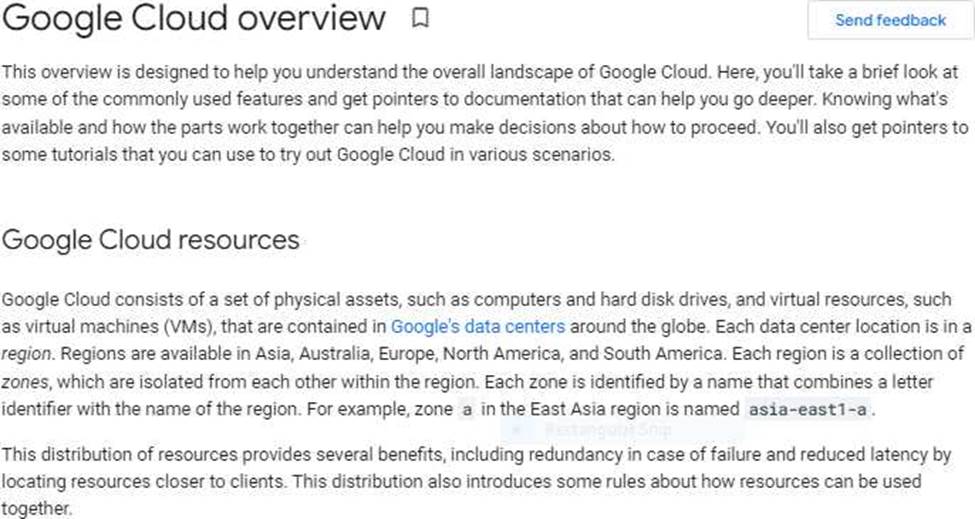Practice Free Cloud-Digital-Leader Exam Online Questions
An organization runs a batch data analysis workload on a virtual machine (VM). The workload can be easily restarted without losing work, and is not time critical. Organizations must choose the lowest cost option to run the workload.
What option should they choose?
- A . A standard VM in a pay-as-you-go model on Compute Engine
- B . A Cloud Function with a small memory limit
- C . A Preemptible or Spot VM on Compute Engine
- D . A custom VM in a pay-as-you-go model on Compute Engine
A retail organization is training a model to recommend products to customers for an ecommerce website. The model was trained on previous purchases, but did not include demographic information on each buyer.
What dimension of the data is responsible for the model’s poor performance?
- A . Accuracy
- B . Validity
- C . Timeliness
- D . Completeness
Considering Different Storage and database options e.g. Cloud Datastore, Cloud SQL, Cloud Stor-age, etc.
Which of the following statements is/are correct? (Select two answer)
- A . Cloud DataStore and Cloud SQL have Terabytes + and Terabytes Capacity respectively.
- B . Cloud Bigtable and Cloud Storage both have Petabytes + capacity.
- C . Cloud Bigtable and Cloud Storage both have not Petabytes + capacity.
- D . None of the above.
An organization wants to collect metrics and metadata from their cloud applications and put them into dashboards.
Which Google Cloud tool should they use?
- A . Cloud Monitoring
- B . Cloud Trace
- C . Cloud Logging
- D . Cloud Debugger
A
Explanation:
https://cloud.google.com/monitoring
In terms of Dockers and Kubernetes, which of the following statements are correct?
- A . Kubernetes uses Docker to deploy, manage, and scale containerized applications.
- B . Difference between Docker and Kubernetes relates to the role each play in containerizing and running your applications
- C . Kubernetes can be used with or without Docker.
- D . All of the above.
D
Explanation:
Kubernetes vs. Docker
Often misunderstood as a choice between one or the other, Kubernetes and Docker are different yet complementary technologies for running containerized applications.
Docker lets you put everything you need to run your application into a box that can be stored and opened when and where it is required. Once you start boxing up your applications, you need a way to manage them; and that’s what Kubernetes does.
Kubernetes is a Greek word meaning ‘captain’ in English. Like the captain is responsible for the safe journey of the ship in the seas, Kubernetes is responsible for carrying and delivering those boxes safely to locations where they can be used.
– Kubernetes can be used with or without Docker.
– Docker is not an alternative to Kubernetes, so it’s less of a “Kubernetes vs. Docker” question. It’s about using Kubernetes with Docker to containerize your applications and run them at scale.
– The difference between Docker and Kubernetes relates to the role each play in containerizing and running your applications.
– Docker is an open industry standard for packaging and distributing applications in containers.
– Kubernetes uses Docker to deploy, manage, and scale containerized applications.
Your organization needs a large amount of extra computing power within the next two weeks.
After those two weeks, the need for the additional resources will end.
Which is the most cost-effective approach?
- A . Use a committed use discount to reserve a very powerful virtual machine
- B . Purchase one very powerful physical computer
- C . Start a very powerful virtual machine without using a committed use discount
- D . Purchase multiple physical computers and scale workload across them
C
Explanation:
When you purchase a committed use contract, you purchase Compute Engine resources―such as vCPUs, memory, GPUs, local SSDs, and sole-tenant nodes―at a discounted price in return for committing to paying for those resources for 1 year or 3 years
What DevOps practice should an organization use when developing their application to help minimize disruption caused by bugs?
- A . Pause production until all bugs have been eliminated
- B . Prioritize fixing large bugs during production because they are easier to review
- C . Implement small changes incrementally to reduce recovery time when bugs appear
- D . Implement large changes together to make rolling back easier when bugs appear
C
Explanation:
One of the key principles of DevOps is to release changes frequently and in small batches. This helps to reduce the risk of disruption caused by bugs. If a bug is introduced in a small change, it is easier to identify and fix the bug without affecting a large number of users.
An organization is migrating their business applications from on-premises to the cloud.
How could this impact their operations and personnel costs?
- A . Reduced on-premises infrastructure management costs
- B . Increased on-premises hardware maintenance costs
- C . Reduced cloud software licensing costs
- D . Increased cloud hardware management costs
An organization provides a loyalty program for its customers. It recently partnered with other businesses so that customers can get loyalty points at a range of other stores.
Why should the organization use application programming interfaces (APIs)?
- A . To migrate all partner data for disaster recovery
- B . To analyze and publish loyalty program statistics to a dashboard
- C . To personalize recommendations for loyalty card users
- D . To connect third-party systems to ensure up-to-date information
What would provide near-unlimited availability of computing resources without requiring your organization to procure and provision new equipment?
- A . Public cloud
- B . Containers
- C . Private cloud
- D . Microservices
A
Explanation:
Reference: https://cloud.google.com/docs/overview

